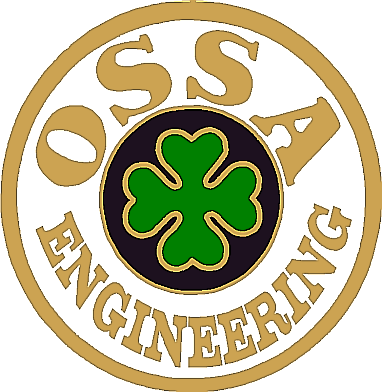History of Ossa
In the early 1920s, Manuel Giro founded a small company that made cinema projection equipment – “Orpheo Sincronic Sociedad Anόnima.” Little did he know that his company’s acronym would eventually become one of the most revered names in motorcycle racing.
It’s About the Bike
A former officer in Spain’s Merchant Marine, Giro had an affinity for motorboat racing. He even built his own engines, some of which powered him to several world speed records. Yet by the early 1930’s, racing the waves had lost its allure. Giro longed for success on the road. In pursuit of victory, he purchased a 500cc Norton, a factory special that had already proven its mettle in the Grands Prix of Europe.
Though fast, the bike was hardly user-friendly, and Giro crashed out of more races than he finished. Undeterred, Giro switched to a BMW, but its 500cc furnace proved woefully underpowered. Hungrier than ever, he replaced the lethargic clunker with a power plant of his own construction – a 6-cylinder 1000cc behemoth straight from his racing boat. As one might predict, the bike was a blur on the straightaway. Turning was a bit of a problem, which nearly killed him the first time he tried it.
So Manuel opted for something with a little more stability in the turns – sidecar racing. His new pursuit soon landed him a Spanish championship.
Getting on in years, Manuel began to devote more time to designing and building his own motorcycles. According to Giro, one of his greatest triumphs and tragedies was a small, efficient, and highly reliable 125cc prototype. He claims he sold the design to the Spanish motoring giant (and his future rival) Montesa Motors, and the engine served as the foundation of that company’s success for years to follow.
Civil War and World War II
Spain’s horrific Civil War failed to kill the Ossa line, but it did manage to end the lives of over a half million Spaniards. The ensuing global war consumed an additional 60 million military and civilian souls. Although the “Good War” created an economic boom in the United States, much of the rest of the planet, including Spain, suffered immeasurably.
But from these ashes, Ossa motorbikes were born.
Ossa Turns to Motorbikes
Inspired by a domestic demand for cheap transportation, Giro and a handful of engineers set about designing a bike for the masses. In 1949, the first true Ossa motorcycle reached production. A 125cc engine with a three-speed gearbox, boasting an impressive top speed of 47 mph, the sporty red machine found a willing audience. Some 14,000 Ossa 125s were sold in a few short years. A number of newer and better models soon followed, including an affordable 50cc moped that could ravel almost 200 miles on a single gallon of gas.
Enter Eduardo
As impressive and popular as Ossas were within Spain, they were virtually unknown elsewhere. Enter Eduardo Giro, Manuel’s brilliant son.
Legend has it that Eduardo built an engine on his own at age 12. By the time he was 15, he had designed and constructed a model airplane engine that could surpass 15,000 rpm. A certifiable genius, he went on to earn a doctorate in engineering. By the 1960s he was head of the Ossa development department. Yet Eduardo knew that in order for the company to survive, it had to look beyond Spain. He quickly surmised that the only way to export the Ossa name was to race the bikes internationally.
In 1965, the factory brought two 175cc prototypes to the starting line of the 24-Hours of Barcelona. Dismissed as rank underdogs, the machines were given no chance against Spain’s two largest motorcycle manufacturers, Bultaco and Montesa.
In a result that astonished the crowd and the motoring world, Ossa swept the top two spots of the class, lapping the closest Montesa 25 times. The little Spanish company was on the world map.
Into the World Marketplace
Fueled by growing international demand for motorcycles, and a booming American affinity for motocross, Ossa steadily became the envy of the sporting community. Quickly the results began to mount. First place in the 1966 Grand Prix of Spain; first and second place in the 250cc class of the 1967 24-Hours of Barcelona; 4th place in the Grand Prix Constructors Points in 1968; three Grand Prix victories in 1969.
Producing motocross, endurance, and trials bikes, Ossa rolled smoothly on. Imports began to flow steadily into the United States through Yankee Motors of New York, and designers at the Yankee works began collaborating with Eduardo and company on innovative twin-engine designs.
Tragedy
Though the Ossa line became synonymous with reliability, the factory could have done nothing to prevent what was about to happen in the 1970 Isle of Man Time Trial Championship.
Ossa’s star pilot, Santiago Herrero, was running high in the ranks when he passed over a patch of melting tar. Suddenly his wheels slipped from beneath him. Herrero crashed spectacularly, and died. Though Ossa continued to race and win (first place in the 1971 and 1972 European Time Trial Championships), much of the impetus was beginning to fade.
Muerte d’Ossa
Democracy, of all things, signaled the demise of Ossa. In 1975 Spain’s dictator Francisco Franco died, unleashing a rise of labor movements across Spain. Two years later nearly the entire workforce of the Ossa factory, over 460 machinists and laborers, walked out in protest of “inhospitable” conditions at the Barcelona plant. Only massive concessions brought the workers back to the shop floor.
Thereafter, rising costs and increasing competition slowly choked the life out of an institution than only years earlier looked to be on top of the world. By 1984 Ossa was under the control of a labor cooperative, and the following year its name was changed to Ossamoto. Sixty years of family ownership had come to an end.
Yet to this day, the heirs of the Giro dynasty still reign by the thousands, as collectors of the legendary Ossa motorcycle.
